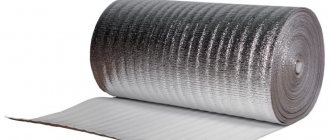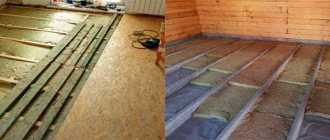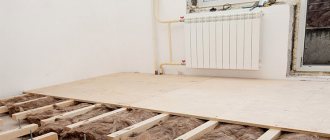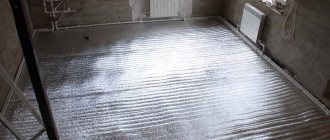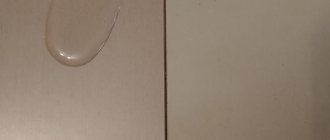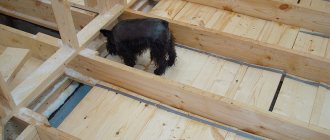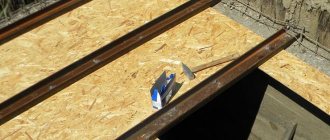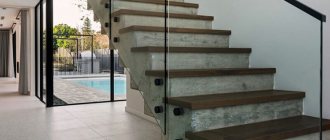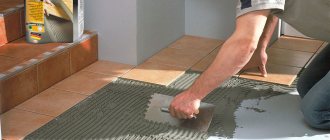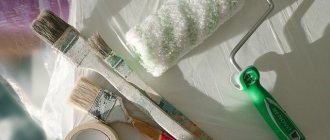High-quality ceiling insulation in a house with a cold roof reduces thermal costs, reduces heating costs and increases living comfort. Thermal insulation is carried out in different ways, using materials of various compositions and forms. How to choose the best option?
We will talk about which methods are most effective in constructing a system that prevents heat loss through the ceiling. We'll tell you what to look for when choosing insulation. In our article you will find valuable recommendations for improving the thermal insulation characteristics of your home.
The need for ceiling insulation
A cold roof is a budget and practical option for organizing the roof of a house for seasonal living. This design significantly saves construction costs, but does not contribute to heat conservation.
It is advisable to resolve the issue of thermal insulation of the ceiling zone at the stage of building a house. However, insulation is often used in the used premises.
The warm air of the heated room rises and, in contact with the cold ceiling, quickly cools. Thermal energy losses through an uninsulated roof and ceiling reach 25-40%
Thermal insulation of the ceiling solves a number of problems:
- Reduces the cooling intensity of heated air, helping to save home heating costs.
- Increases sound insulation in the room, muffling the rumble from the wind or noise from heavy rain.
- In summer, insulating material helps keep the room cool by keeping heated air from outside in.
Insulating the ceiling increases the comfort of a private home and optimizes the microclimate of the room. If the installation technology is followed, thermal insulation prevents the appearance of condensation on structural elements.
Coal slag and sawdust
If we compare these popular options, the better to insulate the ceiling, with the factory ones, then they win only in terms of their cheapness. Coal slag weighs almost as much as expanded clay. This also affects the level of its thermal conductivity. To achieve a good thermal insulation effect, a layer at least 20 cm thick will be required. The use of slag entails the formation of a large amount of dirt. In addition, it quickly absorbs moisture.
As for practically free sawdust, in the process of using them you will have to carry out a number of labor-intensive procedures:
- Dry the material well. To do this, it is poured into a dry room and stored there for about a year.
- Provide protection from rodents and fungus. To do this, slaked lime is mixed into the sawdust in a ratio of 10:2 (sawdust/lime).
Sawdust can be used not only in bulk form, but also to make insulating blocks from them. Do-it-yourself application of bulk thermal insulation for ceilings in a private house can be done exclusively from the attic side.
Methods of thermal insulation of floors
When thinking about how to properly insulate the ceiling of a house under a cold roof, first of all, you need to decide on the method of thermal insulation.
There are two radically different approaches:
- insulation from the attic side;
- installation of thermal insulation material from inside the room.
The first method is more preferable for a number of reasons. Thus, the installation technology itself is significantly simplified - there is no need to build a suspended frame or fix the insulation with glue to the ceiling.
External insulation eliminates expensive repairs inside the room, and also does not reduce the height of the ceilings. The latter is especially true if the distance to the ceiling in the premises does not exceed 2.5 m
Also, with this approach, the risks of condensation are minimized. The same cannot be said about thermal insulation from inside the room.
If you choose the wrong insulation and do not exclude contact of warm air with a cold slab, then water vapor from the room will accumulate - this is fraught with the appearance of dampness, fungus and gradual destruction of the ceiling.
However, in some situations, internal ceiling insulation is a necessary measure, for example:
- lack of access to the attic;
- carrying out reconstruction of an old building with a ready-made attic floor;
- thermal insulation of a garage located in the basement.
If internal insulation is necessary, installation technology should be followed to prevent condensation from occurring inside the building. It is important to comply with two requirements: block the flow of water vapor and use insulation of sufficient thickness.
Vermiculite
This insulation is very similar in structure to mica. As a result of firing, the surface of the material becomes covered with pores, which helps to increase the thermal insulation characteristics. In terms of weight, vermiculite is inferior to expanded clay, but superior to mineral wool. This option is considered the most optimal when choosing the best way to insulate the ceiling.
It is completely fire resistant, does not shrink and does not absorb moisture. This opens up wide opportunities for arranging thermal insulation for block and wooden houses.
Review of the best insulation for ceilings
The choice of installation method also determines the list of possible heat insulator options. When insulating from the attic side, the range of materials is much larger - from natural compounds to technologically advanced modern solutions. Installation from inside the room imposes a number of restrictions.
Regardless of the placement method, the insulation for the ceiling system must have low thermal conductivity. The coefficient determines the ability of the insulator to transfer energy from heated elements to cold ones. The lower the thermal conductivity, the better the material retains heat.
An important selection parameter is moisture resistance. The ability of the material to maintain physical characteristics in a humid environment is especially important when insulating the attic side, when the roofing covering is sufficiently worn out
Additional requirements include:
- durability;
- environmental friendliness and safety for humans;
- low flammability - it is better to use non-flammable insulators, compositions with minimal smoke generation;
- resistance to rodents - important for materials placed in the attic.
It is important to take into account the vapor permeability of the insulation. But there are nuances here. When thermally insulating a concrete slab from the attic side, it is necessary to use a material that allows steam to pass through. For installation from inside the room, on the contrary, use vapor-tight insulation.
Type #1 - mineral wool insulation
The popular heat insulator maintains its leadership position due to its affordability, ease of installation and good thermal efficiency.
Mineral wool has good vapor permeability, so the insulation is perfect for attic work on brick and concrete floors
For installation under a cold roof, mineral wool with a synthetic binder, basalt insulation and glass wool are used. The latter option provides maximum thermal efficiency. The thermal conductivity of glass wool is 0.044 W/(m°C).
However, it should be used with caution - the particles cause irritation to the skin and mucous membranes. Glass wool is not acceptable for indoor use. Basalt insulation does not have these disadvantages. Additional advantages of the material: fire safety and plasticity.
General disadvantages of mineral wool materials:
- water absorption;
- low strength;
- tendency to shrink;
- content of unsafe components - abrasive particles or formaldehyde resins.
To place layers of mineral wool, you will need to install wooden logs; it is advisable to waterproof the insulation itself on top.
Type #2 - bulk cellulose insulator
Bulk material produced from paper and pulp waste. To protect against rotting and fire, synthetic components are added to ecowool.
The material is used for external insulation - in the attic. Ecowool is sprayed dry over the ceiling or applied mixed with glue. Requires special equipment to operate
The characteristics of cellulose insulation and the technology of its application have endowed the modern method of thermal insulation with a number of advantages:
- good thermal efficiency - thermal conductivity is about 0.038 W/(m°C);
- the material fills all the voids and cracks, forming a solid fabric - no cold bridges are formed;
- due to its light weight, ecowool of any thickness can be laid;
- durability of service and preservation of original properties;
- environmental friendliness - ecowool does not emit toxic fumes;
- low flammability and self-extinguishing ability;
- vapor permeability.
Despite its many advantages, ecowool has not gained much popularity. The main reasons for low demand: high cost, impossibility of installation by hand.
In addition, ecowool is prone to shrinkage and wrinkles; it is advisable to provide a rigid support on top for movement around the attic.
Type #3 - slab polymer types
This group of insulation materials includes: polystyrene foam and extruded polystyrene foam (EPS). Their thermal efficiency exceeds that of mineral wool insulation. The leader is EPPS, the thermal conductivity coefficient is 0.038 W/m°C.
Expanded polystyrene is superior to polystyrene foam in terms of strength, rigidity and fire safety. However, in case of fire, EPS boards also emit toxic fumes
Polystyrene foam is cheaper than polystyrene foam. Among the general advantages are:
- water resistance;
- low biological activity;
- wide choice of geometric sizes and thicknesses.
Both materials are vapor-tight, so they are used to insulate concrete and brick surfaces.
Another type of plastic polymer is penofol. This is a thin sheet of polyethylene foam, covered on one side with aluminum foil.
The material is suitable for installation from inside the room. Penofol is placed with the foil side facing the inside of the room - the canvas not only retains heat, but also partially reflects it back.
It is advisable to use foamed polyethylene as an independent material in areas with a mild climate. In regions with harsh winters, a combination of penofol and penoplex shows a good effect.
Type #4 - bulk heat insulator
Lightweight porous material in the form of round granules. Contains baked clay. The natural origin of the insulation explains its environmental friendliness.
Additional benefits of expanded clay:
- fire resistance;
- ensuring a good degree of sound insulation;
- durability;
- chemical inertness;
- not of interest to rodents;
- the insulation does not produce dust.
The thermal efficiency of expanded clay depends on the density of the embankment and the size of the granules.
The best option for insulating an attic is grains measuring 4-10 mm. The higher the density of expanded clay flooring, the worse its thermal insulation qualities
To ensure heat conservation, you will have to use an embankment 20 cm thick or more; in cold regions, the layer is increased to 40-50 cm. This leads to an increase in the cost of the insulation procedure and significantly increases the load on the floor.
Type #5 - liquid polyurethane
Polyurethane foam is supplied to the surface under pressure; special equipment is used for spraying. Polyurethane foam is an excellent solution for attic floors with complex terrain and thermal insulation of hard-to-reach places.
The main advantages of ceiling insulation with foam:
- formation of a seamless sealed coating;
- high adhesion to materials - polyurethane foam fills all cracks and voids;
- low water absorption;
- excellent thermal efficiency due to the porous structure of the hardened foam - thermal conductivity of about 0.027 W/m°C;
- preservation of qualities in humid conditions;
- possibility of multi-layer spraying – relevant for cold regions;
- providing acoustic insulation;
- durability of the coating – service life is about 25 years;
- speed of processing;
- resistance to microorganisms;
- lightness of the material - does not put pressure on the ceiling.
Polyurethane foam is difficult to ignite, the insulation does not propagate combustion.
Spray insulation is considered one of the best solutions for treating attic floors. The limited use of polyurethane foam is explained by the high cost of the method
The total cost includes the price of the insulation itself and the cost of attracting craftsmen with equipment. Spraying foam cannot be carried out if the air temperature in the attic is below +10 ° C.
Type #6 - natural materials
The main advantages of traditional methods: affordable cost and environmental friendliness. The technique of using and the effectiveness of natural materials such as sawdust and algae varies.
Features of sawdust insulation
Bulk woodworking waste is often mixed with shavings and distributed over the ceiling from the attic side.
Insulation methods:
- Dry backfill . Wooden logs are installed on the floor, and the cells are filled with sawdust. The material shrinks over time and requires periodic renewal.
- Wet method . Combine sawdust, cement and water in a ratio of 10:2:1.5, respectively. This thermal layer is more durable.
Weaknesses of sawdust: flammability, rodent hazard and water absorption.
To protect against pests, slaked lime and fungicides are added to the bulk insulation. To counteract fire, sawdust is mixed with fire retardants
Characteristics and varieties of algae
In coastal areas, algae is widely used; the second name for insulation is damask. The material is distinguished by its naturalness and good thermal insulation characteristics. Rodents do not grow in algae, and the insulation itself is not afraid of moisture and does not rot.
There are three types of damask:
- hanging - bales or loose rolls collected from dried compressed seaweed;
- mats in meshes - 10 cm thick canvases, tied with synthetic thread for ease of installation;
- dense slabs - up to 85% of algae are present in the composition, the rest is a binding component, for example, silicone.
In terms of thermal efficiency, damask is significantly inferior to many insulation materials; the heat capacity coefficient is 0.087 W/(m°C).
Algae do not like mechanical influences; with frequent walking they turn into dust. Therefore, it is better to lay boards on top of the damask
Expanded clay
The most common type of bulk insulation presented on the construction market is expanded clay. It looks like light and durable brownish round stones. To make this material, special clay is selected, which is first melted and then cooled. It is the simplicity of the production technology that explains the low cost of expanded clay.
As for the thermal insulation properties of this insulation, they are at an average level. To insulate the ceiling in a private house, it is necessary to use an expanded clay layer with a thickness of 20 cm, only in this case the desired effect is achieved. Due to their strength, the granules can easily cope with the load from the concrete screed. However, one should take into account the poor resistance to moisture and the significant weight of the material. Therefore, before using expanded clay, you need to take care of a durable floor.
Calculation of the thickness of the thermal insulation layer
The efficiency of thermal insulation depends on the accuracy of determining the thickness of the insulation, which is part of the thermal engineering calculation. In addition, the indicator allows you to calculate the loads placed on the ceiling structure. When calculating, the values of the permissible weight and the required thermal protection are compared.
The thickness of the insulation is determined by the formula
q = R * k,
Where:
- q – thickness of heat-insulating material, m;
- R – thermal resistance, m2°С/W;
- k – thermal conductivity coefficient of insulation, W/(m°C).
The R value is determined from tabular data - the indicator is calculated for each region, taking into account the climate characteristics.
For example, the standardized thermal resistance of floors for Nizhny Novgorod is 4.26 m2°C/W. If you use penoplex to insulate the ceiling, you will need a layer of thermal insulation 12 cm thick
To calculate, it is enough to multiply the indicators 4.26 and 0.038. The last value is the thermal conductivity coefficient of extruded polystyrene foam. The weight of the ceiling is calculated based on the volume of insulation and its density. The first indicator is determined by the product of the area and thickness of the thermal insulation, the second - the table value.
The minimum load on the ceiling is exerted by polyurethane foam and ecowool, their density is in the range of 25-60 kg/cu. m. One of the heaviest insulation materials is expanded clay - 180-330 kg/cu.m. m.
Styrofoam
It is recommended to insulate block houses with reinforced concrete floors with cheap PSB-S25 foam plastic. As for higher quality extruded polystyrene foam, you will have to pay 2–3 times more money for it. When using reinforced cement screed on the attic floor side, it is not practical to buy more expensive material.
Extruded polystyrene foam is especially distinguished by its complete impermeability to moisture. As for some vapor permeability of polystyrene foam, due to the insignificance of this coefficient, you can ignore it. It is recommended to use such slabs in wooden houses very carefully, otherwise, due to clogging of the wood, rotting processes will begin.
A common disadvantage of styrene boards is their poor resistance to elevated temperatures. When passing the border of +70 degrees, the material begins to break down and release harmful toxins. Such temperatures are possible in the kitchen and in the steam room: therefore, it is not recommended to insulate the ceilings in these rooms with styrene-based materials.
Features of installation of different materials
The tactics of action depend on the chosen material and the location of its placement - from inside the room or from the attic.
Laying mineral wool
Installation of insulation is carried out along the attic floor.
When constructing a thermal insulation cake, it is important to meet two conditions:
- ensure protection of mineral wool from water vapor coming from inside a warm room;
- arrange ventilation of the outer surface to ventilate moisture from the insulation.
Mineral wool slabs are laid between beams or strips of prepared sheathing. Can be mounted on the ceiling surface.
Before starting work, it is necessary to check the boards for rot and treat the wooden elements with an antiseptic. Make sure the roof is not leaking
The surface is cleared of debris, and if necessary, a wooden frame is constructed.
Further actions:
- Install a vapor barrier membrane.
- Roll out rolls or place mats between beams.
- Install a wooden base, maintaining a ventilation gap between the insulation and the hard floor.
The last step can be missed. However, it will not be possible to walk in the attic or store things there, since mineral wool cannot be pressed.
Internal lining with expanded polystyrene
This thermal insulation option is suitable for concrete ceilings. Expanded polystyrene slabs are fixed to the surface with glue and secured with “fungi”.
At the preparatory stage, the ceiling is cleared of debris and old finishing, holes, cracks and gaps between the slabs are sealed.
Before installing the insulation, the ceiling is treated with an antifungal compound and primer.
The procedure for attaching polystyrene foam boards:
- Apply glue to the insulation, apply and press it to the ceiling.
- Cover the entire area with slabs, leaving no gaps between the elements.
- Use a hammer drill to drill holes for fasteners.
- Kill the fungi.
- Foam the joints and gaps between the plates.
- Cut off the remaining foam and fix the reinforcing mesh with adhesive.
- The surface should be primed and plastered.
After the layer has dried, clean the ceiling and apply the final decorative coating.
Filling the attic with expanded clay
The minimum layer of bulk insulation is 20 cm. To adjust the height of the backfill, you need to prepare a beacon - make the necessary mark on a piece of reinforcement, securing a piece of electrical tape.
If a wooden base is insulated with expanded clay, then the floor must first be covered with waterproofing extending onto the walls. Polyethylene film will do
There is no need to lay a water barrier on a concrete base.
Sequence of work:
- Pour in expanded clay and distribute the granules evenly.
- Check the thickness of the insulating layer. Its height should be 3-4 cm below the level of the flooring. If this norm is neglected, then when walking through the attic the sound of granules rubbing will be heard.
- Lay a layer of vapor barrier membrane and seal the joints of the panels with tape.
- Install a rigid base. Boards, fiberboard or OSB panels are suitable.
The floor on top of expanded clay makes it easier to move around the attic and increases the effectiveness of the insulation cake.
Application of Spray Insulation
It will not be possible to carry out the work yourself, since spraying will require expensive equipment - a high-pressure apparatus. In addition, skills in working with equipment are required to evenly distribute polyurethane foam.
To start the device, a voltage of 380 V is required. If there is a two-phase network in the house, a generator is connected that produces the required value of the electric field.
It is better to entrust the work to a specialized company and conclude an agreement with them for the provision of services. At the appointed time, a team arrives and extends a hose with a gun into the house.
Recommended work order:
- Install wooden joists on the attic floor. They will be needed for subsequent fastening of the flooring.
- Fill the device with components in the required proportions.
- Set the gun to the minimum foam supply force.
- Apply polyurethane foam between the joists in an even layer.
- Wait for the composition to dry. If the thickness of one layer is not enough, then the treatment must be repeated.
- Level the cured coating by cutting off the excess to the level of the joist.
- Mount on boards on a rigid base.
To insulate a small ceiling yourself, you can use a disposable foam spray kit.
The kit contains everything you need: cylinders with components for preparing foam insulation, a spray gun, hoses, personal protective equipment
Assembly and preparation takes a couple of minutes, no power supplies are needed - the device operates autonomously.
Homemade sawdust slabs
An excellent material option for insulating the ceiling in a private home.
The technology for its manufacture is very simple:
- Dry aged sawdust is mixed with M500 cement in a ratio of 10:1.
- 1 part of slaked lime is added to the resulting composition.
- Final mixing without adding water is carried out in a concrete mixer.
- After achieving homogeneity, pour 2 parts of water into the powder and mix again.
- Boric acid, copper sulfate or gelatin are sometimes used to enhance it. The last option is the most preferable, since it makes the slabs more elastic.
- The finished mixture is poured into homemade molds.
After drying, slabs of strict dimensions are obtained. There is also the option of laying the mixture mixed in a concrete mixer immediately between the joists in the attic. This makes it possible to obtain a monolithic slab, tightly adjusted to the dimensions of the spaces between the lintels.
Foam
Among the common foam insulation materials, materials based on polyurethane and polystyrene (penoizol) are most often used.
- Polyurethane foam - a relatively new and expensive insulation material, its structure resembles foam plastic. Moisture resistant, retains performance properties for more than 50 years, low thermal conductivity (0.02 W/mK). Disadvantages: high cost (from 20,000 rubles per 1m3), application requires special equipment.
- Penoizol. In fact, this is ordinary foam plastic, the main difference is a seamless monolithic coating.
The process of applying penoizol to a cold attic
Thermal conductivity is almost twice as high as that of polyurethane foam - 0.42 W/mK. It does not rot, does not bloom, rodents and other living creatures do not grow in it. It is airtight, so it should not be used to fill the wooden floor of the attic. Relatively high toxicity does not allow indoor use. Price from 2500 RUR per m3.
Reinforced concrete slabs
The procedure for how to insulate the ceiling of a house from the inside with your own hands using concrete floors:
- Check the level of sealing of round cavities inside the material. If there are no traffic jams, this flaw must be corrected. To do this, the ends of the slabs are treated with polyurethane foam, cutting off all residues after it hardens. Cement-sand mortar is used as a putty for holes.
- When choosing the thickness for the material, you should focus on the following recommendations: polystyrene foam - from 50 mm, extruded polystyrene foam - from 30 mm, high-density mineral wool - 100 mm.
- Prepare the concrete base. This implies complete cleaning of its surface from the previous finish: this could be whitewashing, painting or wallpaper. It is also necessary to remove all fasteners protruding above the surface level. The cleaned base is primed with deep penetration acrylic impregnation.
- To fix the slabs to the ceiling surface, construction adhesive and umbrella dowels are used. Every 1 m² of material must be reinforced with 5 fixation points. As for the choice of glue, styrene-based boards adhere well to the Ceresit CT83 mixture: it was specially developed specifically for such materials. To glue basalt slabs, you can use any tile mixture.
- The installation of individual slabs must be carried out staggered, as when laying bricks (when the rows are shifted relative to each other).
- Although the adhesive solution has excellent holding properties, the insulation fixed to the canopy requires additional fastening. To do this, drill holes directly through the layer of slabs. The holes must be “blind” and have a depth of up to 50 mm. Each of them is equipped with a dowel-umbrella, with a central spacer rod located in the umbrella.
- After this, the procedure for thermal insulation of the ceiling from the inside can be considered complete. On top of the laid insulation, it is necessary to think in advance about the finishing that would correspond to the general atmosphere of the room.
Manufacturers
On the market you can find materials for insulation of domestic production, as well as insulation from the USA, Finland, Germany, France and other countries.
The following brands are available:
- TechnoNikol;
- Knauf;
- Isoroc;
- Isover;
- Paroc;
- Rockwool;
- Ruspanel;
- Soudal;
- Tytan;
- Ursa;
- Akterm;
- Penoplex;
- Penofol;
- Tepofol;
- Tilit;
- And others.
Go to any well-known online store and use filters to look at the characteristics of each individual product.
As you can see, there are very different methods of insulation, but price always remains an important issue.
Loose penoizol
Penoizol flakes have a random shape.
In appearance, penoizol looks like foam chips, but if you look more closely, the difference is obvious. Despite the visual similarity, these are two completely different materials. Penoizol is more reminiscent of snow flakes, it does not have an ideal ball shape, this material is softer. Penoizol is used as fill-in insulation for walls and horizontal ceilings. In addition, it is also available in sheets, but is mainly used in liquid form. Unlike polystyrene foam, penoizol:
- does not burn;
- does not smoke;
- allows moisture to pass through, but does not absorb it.
The thermal conductivity characteristics of both materials are almost equal.
Penoizol backfill insulation for walls is made from resin. The quality of the material primarily depends on the quality of the resin used for production.
First, the liquid substance is poured into blocks, about a meter by meter. Then the blocks are cut into sheets, and only then the sheets are crumbled. Installation is carried out using a blowing machine or manually. When working, you need to control the degree of density of the material.
Expanded polystyrene crumbs
Styrofoam crumbs.
The first bulk insulation we will consider is polystyrene foam. If you look closely at a sheet of polystyrene foam, you can see that it consists of many balls. These component parts may not be fastened together, and their density decreases. If you take a sheet of polystyrene foam and loosen it into individual balls, they will take up much more space. Naturally, as the density decreases, the material’s resistance to heat transfer decreases somewhat, so unless absolutely necessary, it is better to use sheets. Also read: “Technological features of insulating facades with foam plastic.”
Bulk insulation for walls made from foam spheres is used only when it is necessary to fill the cavities of already built structures. The crumbs are simply blown out using a special machine, trying to achieve maximum density. The disadvantage of crumbs is that the insulation can shrink. In addition, the material:
- burns;
- emits toxic smoke;
- Rodents feel great in it.
This bulk wall insulation is transported in plastic bags. Can be used to insulate floors, ceilings, and pitched roofs.
How does a chimney for a solid fuel boiler differ from its counterpart for a gas heater with a sealed combustion chamber?
You will find everything about how to choose a chimney for a gas boiler here.
Foundation
The foundation needs thermal insulation to prevent annual temperature fluctuations. The technology for its protection by filling with expanded clay is as follows:
- A trench is dug around the finished foundation with a depth corresponding to the amount of soil freezing. The trench width is at least 50 cm.
- In the resulting cavity, formwork is placed from available materials (boards, slate sheets).
- Waterproofing work is carried out on the bottom and side surfaces (film, roofing felt, etc.).
- Expanded clay gravel is filled to zero level and compacted. The surface is leveled.
- The insulation on top is also insulated from moisture.
- Then a blind area is made around the foundation or a thin layer of soil is poured.
Roofs
Insulation of a pitched roof with expanded clay is rarely carried out, but the technology is simple:
- boards are packed along the bottom of the rafters, forming a plane on which the insulation will be poured;
- A vapor barrier film made of polyethylene is laid overlapping. It has several functions: vapor and waterproofing, preventing small fractions of pellets from spilling through the cracks between the boards;
- Ceramic granules are poured over the film in an even layer;
- the thermal insulation layer is covered with a vapor barrier membrane;
- a counter-lattice is filled to create a ventilation gap;
- boards are attached on top of the counter-lattice to secure the roofing material;
- the roof is being installed.
Recommendations
For backfilling there are the following recommendations. Firstly, bulk material settles over time, so it needs to be compacted well. It is advisable to use boiler slag and expanded clay in regions where winter temperatures do not drop below -20°C. Insulation of pitched roofs with expanded clay and similar compounds is carried out from the outside, after laying the vapor barrier. Transverse stops are installed along the slope between the rafters - they evenly distribute the insulation.
After laying it on the floor or in the basement, it is well compacted to prevent shrinkage and deformation of the finish. The only problem is moisture ingress; bulk insulation materials are quite hygroscopic. In baths and saunas and, indeed, everywhere, the insulation layer must have high-quality hydro- and vapor barrier. It is necessary to ensure that there are no cracks in the finishing and that bulk material does not spill through them. It is also worth remembering that expanded clay is quite heavy. It is necessary to ensure that its mass does not push apart too weak partitions or walls.
Choose by cost
The cost of insulation changes very quickly. Therefore, as an example, we present a small plate with the cost of some popular insulation materials.
| Mineral wool | Amount in a package | Thickness, mm | Cost in rubles | Cost in dollars |
| TechnoNIKOL Greenguard | 4 | 100 | 380 rubles | 6,5 |
| Paroc Extra | 8 | 100 | 1000 rubles | 17,2 |
| Isover Classic cooker | 10 | 100 | 525 rubles | 9 |
| Izovol St-50 | 4 | 100 | 400 rubles | 6,9 |
| Styrofoam | Amount in a package | Thickness, mm | Cost in rubles | Cost in dollars |
| Knauf Therm | 10 | 100 | 2200 rubles | 38 |
| TechnoNIKOL Carbon Eco | 4 | 100 | 2600 rubles | 45 |
| Penoplex Comfort | 18 | 20 | 1200 rubles | 20,6 |
Blowing polyurethane foam will cost 200-300 rubles per square meter (labor and material). Ecowool will cost 3000-4000 rubles per cubic meter. The cheapest insulation is probably sawdust, 300-500 rubles per cubic meter. Using the above figures, you can calculate the approximate cost per square meter of insulation.
